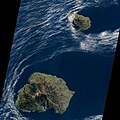Payl:Prince Edward Islands, EO-1 ALI satellite image, 5 May 2009.jpg

Gidak-on ning maong paunang tan-aw: 600 x 600 ka mga piksel. Uban pang mga resoluyon: 240 x 240 ka mga piksel | 480 x 480 ka mga piksel | 768 x 768 ka mga piksel | 1,024 x 1,024 ka mga piksel | 2,048 x 2,048 ka mga piksel | 5,000 x 5,000 ka mga piksel.
Tibuok resolusyon (5,000 × 5,000 pixels, size sa payl: 5.18 MB, MIME type: image/jpeg)
Kaagi sa payl
I-klik ang petsa/oras aron makit-an ang hulagway sa payl niadtong panahona.
| Petsa/Takna | Thumbnail | Mga dimensyon | Tiggamit | Komento | |
|---|---|---|---|---|---|
| kasamtangan | 21:19, 28 Enero 2013 |  | 5,000 × 5,000 (5.18 MB) | Slick-o-bot | Bot: convert to a non-interlaced jpeg (see bug #17645) |
| 00:57, 5 Abril 2011 |  | 5,000 × 5,000 (5.08 MB) | Avenue | {{Information |Description ={{en|1=Satellite image of South Africa's Prince Edward Islands. Prince Edward Island is the smaller island near the top; Marion Island is the larger island below. Original NASA caption, for a version cropped to show just Ma |
Mga paggamit sa payl
Ang mosunod nga mga panid misumpay niining payl:
Global nga paggamit sa payl
Kining ubang wiki naggamit ning maong payl:
- Paggamit sa af.wikipedia.org
- Paggamit sa ar.wikipedia.org
- Paggamit sa ca.wikipedia.org
- Paggamit sa cs.wikipedia.org
- Paggamit sa da.wikipedia.org
- Paggamit sa de.wikipedia.org
- Paggamit sa eo.wikipedia.org
- Paggamit sa es.wikipedia.org
- Paggamit sa eu.wikipedia.org
- Paggamit sa fi.wikipedia.org
- Paggamit sa fr.wikivoyage.org
- Paggamit sa it.wikipedia.org
- Paggamit sa nn.wikipedia.org
- Paggamit sa no.wikipedia.org
- Paggamit sa pl.wikipedia.org
- Paggamit sa sv.wikipedia.org
- Paggamit sa ur.wikipedia.org
- Paggamit sa www.wikidata.org




